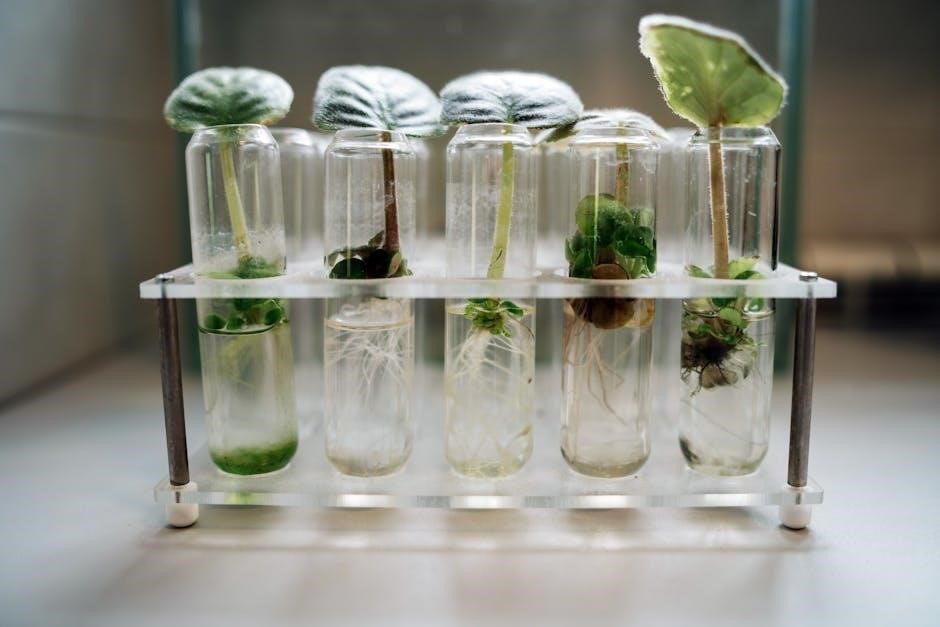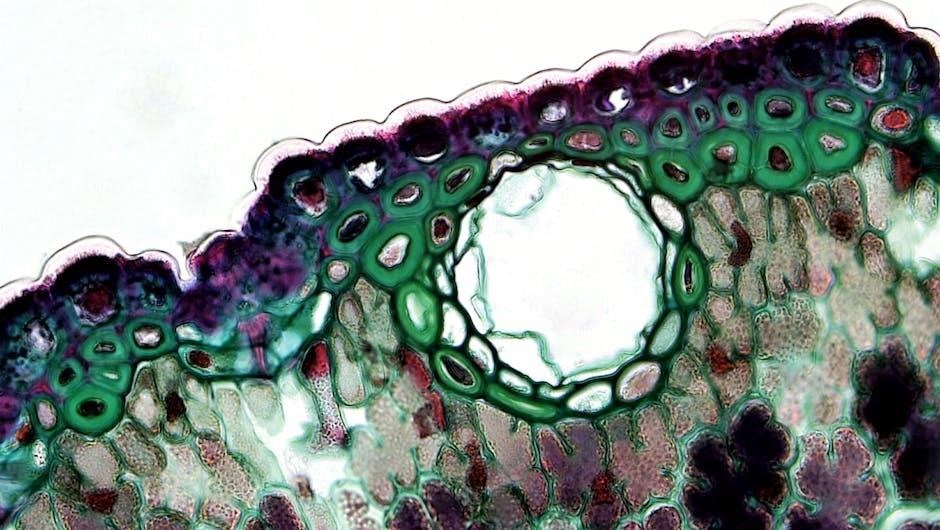Overview of Photosynthesis and Cellular Respiration
Photosynthesis and cellular respiration are essential biological processes that convert energy between light and chemical forms. Photosynthesis occurs in chloroplasts‚ while cellular respiration occurs in mitochondria‚ supporting life.
Photosynthesis and cellular respiration are vital biological processes that sustain life. Photosynthesis converts light energy into chemical energy‚ producing glucose and oxygen‚ while cellular respiration breaks down glucose to release energy. These processes occur in specific organelles—chloroplasts for photosynthesis and mitochondria for respiration. They are interdependent‚ with photosynthesis supplying oxygen and cellular respiration producing carbon dioxide‚ creating a balanced cycle essential for life on Earth.
1.2 Importance of These Processes in Living Organisms
Photosynthesis and cellular respiration are critical for life‚ providing energy and organic molecules. Photosynthesis produces oxygen and glucose‚ essential for cellular respiration and food production. Cellular respiration generates ATP‚ the energy currency of cells‚ enabling growth‚ movement‚ and reproduction. Together‚ these processes maintain the balance of oxygen and carbon dioxide in ecosystems‚ supporting the survival of autotrophs and heterotrophs alike‚ forming the foundation of life on Earth.
Chemical Equations for Photosynthesis and Cellular Respiration
Photosynthesis: 6CO₂ + 6H₂O + light → C₆H₁₂O₆ + 6O₂. Cellular respiration: C₆H₁₂O₆ + 6O₂ → 6CO₂ + 6H₂O + ATP. These equations show energy transformation between light and chemical forms.
2.1 Balanced Chemical Equation for Photosynthesis
The balanced chemical equation for photosynthesis is: 6CO₂ + 6H₂O + light → C₆H₁₂O₆ + 6O₂. This equation shows how carbon dioxide and water‚ in the presence of sunlight‚ are converted into glucose and oxygen. Chlorophyll plays a central role in absorbing light energy‚ while the chloroplast serves as the site for this process; The equation highlights the storage of light energy in chemical bonds‚ making it a vital energy source for life on Earth.
2.2 Balanced Chemical Equation for Cellular Respiration
The balanced chemical equation for cellular respiration is: C₆H₁₂O₆ + 6O₂ → 6CO₂ + 6H₂O + ATP. This equation represents the breakdown of glucose and oxygen into carbon dioxide‚ water‚ and energy in the form of ATP. The process occurs in mitochondria and involves glycolysis‚ the Krebs cycle‚ and the electron transport chain. It releases stored energy from glucose‚ essential for cellular functions‚ and is a critical energy-producing mechanism for living organisms.
Relationship Between Photosynthesis and Cellular Respiration
Photosynthesis and cellular respiration are interconnected‚ exchanging oxygen and carbon dioxide‚ forming a vital energy cycle. Photosynthesis produces oxygen‚ while respiration consumes it‚ sustaining life processes.
3.1 Interconnection in Ecosystems
Photosynthesis and cellular respiration form a vital cycle in ecosystems‚ exchanging oxygen and carbon dioxide. Plants and algae produce oxygen through photosynthesis‚ which animals and other organisms use for respiration. Conversely‚ carbon dioxide released during respiration is absorbed by plants for photosynthesis. This interdependent relationship maintains atmospheric balance and sustains life‚ illustrating how energy flows through ecosystems while recycling essential resources continuously. This interconnection is fundamental to the survival of all living organisms on Earth.
3.2 Reactants and Products of Each Process
Photosynthesis uses carbon dioxide‚ water‚ and light energy to produce glucose and oxygen. Cellular respiration uses glucose and oxygen to produce carbon dioxide‚ water‚ and ATP energy. The oxygen released in photosynthesis is consumed in cellular respiration‚ while the carbon dioxide produced in respiration is used in photosynthesis. This reciprocal exchange sustains life‚ creating a balanced cycle of energy transformation and resource recycling in ecosystems.
Structure and Function of Chloroplasts and Mitochondria
Chloroplasts and mitochondria are organelles central to energy production. Chloroplasts contain chlorophyll for photosynthesis‚ while mitochondria house the Krebs cycle and electron transport chain for cellular respiration.
4.1 Chloroplast: Site of Photosynthesis
The chloroplast is the organelle where photosynthesis occurs‚ converting light energy into chemical energy. It contains chlorophyll‚ which absorbs light‚ and structures like thylakoids and grana for light reactions. The stroma hosts the Calvin cycle‚ producing glucose. Essential for autotrophs‚ chloroplasts sustain life by generating oxygen and organic compounds‚ linking light energy to biochemical pathways.
4.2 Mitochondria: Site of Cellular Respiration
Mitochondria are the powerhouses of cells‚ where cellular respiration occurs to produce ATP. They contain compartments for glycolysis‚ the Krebs cycle‚ and the electron transport chain. Oxygen is essential for ATP synthesis in the electron transport chain‚ converting glucose into energy. This process sustains heterotrophs by breaking down organic molecules‚ releasing carbon dioxide and water as byproducts‚ and maintaining energy flow in ecosystems.

Stages of Photosynthesis
Photosynthesis occurs in two main stages: the light reaction and the Calvin cycle. The light reaction captures sunlight‚ producing ATP and NADPH. The Calvin cycle uses these to fix CO2 into glucose.
5.1 Light Reaction
The light reaction occurs in the thylakoid membranes of chloroplasts. Chlorophyll and other pigments absorb light energy‚ initiating the process. Water is split (photolysis)‚ releasing oxygen and hydrogen ions. Energy from light drives the formation of ATP and NADPH through the electron transport chain and chemiosmosis. These molecules are vital for the Calvin cycle‚ providing energy to fix carbon dioxide into glucose.
5.2 Calvin Cycle (Dark Reaction)
The Calvin cycle occurs in the stroma of chloroplasts and requires ATP and NADPH from the light reaction. Carbon dioxide is fixed into a 3-carbon molecule (PGA) via the enzyme RuBisCO. ATP and NADPH reduce PGA to form glucose and regenerate RuBP. This cycle produces organic molecules (glucose) for energy storage and is essential for carbon fixation. It operates in the dark but depends on light reaction products for energy.

Stages of Cellular Respiration
Cellular respiration involves glycolysis‚ Krebs cycle‚ and electron transport chain. These stages break down glucose to produce ATP‚ releasing energy for cellular functions. Essential for life.
6.1 Glycolysis
Glycolysis is the first stage of cellular respiration‚ occurring in the cytoplasm. It breaks down glucose into two molecules of pyruvate‚ generating a small amount of ATP and NADH. This process does not require oxygen‚ making it a universal pathway for energy production in most living organisms. It is a critical initial step that prepares glucose for further breakdown in the Krebs cycle‚ ensuring energy release for cellular functions.
6;2 Krebs Cycle
The Krebs cycle‚ also known as the citric acid cycle‚ occurs in the mitochondrial matrix. It breaks down acetyl-CoA into carbon dioxide‚ producing NADH and FADH2 for the electron transport chain. This aerobic process generates a small amount of ATP directly. It is a critical step in cellular respiration‚ linking glycolysis to the electron transport chain and enabling the release of stored energy from glucose.
6.3 Electron Transport Chain
The electron transport chain (ETC) occurs in the mitochondrial inner membrane. It transfers electrons from NADH and FADH2 to oxygen‚ creating a proton gradient. This gradient powers ATP synthase to produce ATP through oxidative phosphorylation. Oxygen acts as the final electron acceptor‚ forming water. The ETC is a critical step in cellular respiration‚ generating the majority of ATP during aerobic respiration and linking the Krebs cycle to energy production in cells.
Energy Storage and Release
Energy is stored in ATP during photosynthesis and released through cellular respiration. Photosynthesis converts light energy into chemical energy‚ while respiration breaks down glucose to release energy‚ sustaining life.
7.1 Role of ATP in Energy Transfer
ATP (adenosine triphosphate) is a crucial energy carrier in both photosynthesis and cellular respiration. During photosynthesis‚ ATP is produced in the light reaction and used to fuel the Calvin cycle‚ converting light energy into chemical energy. In cellular respiration‚ ATP is generated through glycolysis‚ the Krebs cycle‚ and the electron transport chain‚ releasing energy from glucose. This molecule acts as a bridge‚ storing and transferring energy efficiently between these processes‚ ensuring cellular functions are powered continuously.
7.2 Conversion of Light Energy to Chemical Energy
Photosynthesis converts light energy into chemical energy by capturing sunlight through chlorophyll in the thylakoid membranes. Light reactions produce ATP and NADPH‚ which power the Calvin cycle. This cycle fixes CO2 into glucose‚ storing energy in organic molecules. Conversely‚ cellular respiration releases this stored energy by breaking down glucose‚ producing ATP for cellular activities. This interplay ensures energy is cycled efficiently‚ sustaining life and ecological balance through these interconnected processes.
Key Vocabulary
This section defines essential terms like autotrophs and heterotrophs‚ explaining their roles in energy production. Chlorophyll and biochemical pathways are also covered to enhance understanding of the processes.
8.1 Autotrophs and Heterotrophs
Autotrophs‚ like plants‚ produce their own food using light energy through photosynthesis. Heterotrophs‚ such as animals‚ rely on consuming other organisms for energy. Autotrophs form the base of food chains‚ while heterotrophs depend on them for survival. This interdependence highlights the fundamental relationship between these two groups in sustaining life and energy flow within ecosystems.
8.2 Chlorophyll and Its Role
Chlorophyll is a green pigment found in chloroplasts‚ essential for absorbing light energy‚ primarily blue and red wavelengths. It plays a crucial role in the light reaction of photosynthesis‚ initiating the conversion of light energy into ATP and NADPH. Chlorophyll’s unique structure allows it to capture sunlight efficiently‚ enabling plants to synthesize glucose from carbon dioxide and water‚ making it vital for sustaining life on Earth.
8.3 Biochemical Pathways
Biochemical pathways are sequences of enzyme-catalyzed reactions that convert substrates into products. In photosynthesis‚ pathways include the light reaction and Calvin cycle‚ producing ATP and glucose. Cellular respiration involves glycolysis‚ the Krebs cycle‚ and the electron transport chain‚ breaking down glucose to release energy. These pathways are interconnected‚ ensuring energy flow and nutrient cycling in ecosystems‚ with photosynthesis producing oxygen and organic molecules‚ while respiration consumes them to generate ATP‚ sustaining life processes.

Review Questions and Diagrams
This section provides key questions and visual aids to reinforce understanding of photosynthesis and cellular respiration. Diagrams illustrate energy flow‚ processes‚ and interconnections between the two.
9.1 Key Concepts to Understand
Key concepts include understanding the chemical equations for photosynthesis and cellular respiration‚ the roles of chloroplasts and mitochondria‚ and the stages of each process. Photosynthesis converts light energy into chemical energy‚ while cellular respiration breaks down glucose to release energy; The interconversion of energy forms and the role of ATP are central. Chlorophyll’s role in absorbing light and the importance of water and carbon dioxide in photosynthesis are vital. These processes sustain life by enabling energy conversion and storage.
9.2 Diagrams Linking Photosynthesis and Cellular Respiration
Diagrams linking photosynthesis and cellular respiration illustrate the flow of energy and materials between the two processes. Photosynthesis produces oxygen and glucose‚ while cellular respiration uses these to release energy. Visual representations‚ such as flowcharts or cycle diagrams‚ highlight the interdependence of these processes. They show how energy from sunlight is stored in glucose during photosynthesis and then released during cellular respiration‚ emphasizing the cyclical nature of energy transformation in ecosystems.
